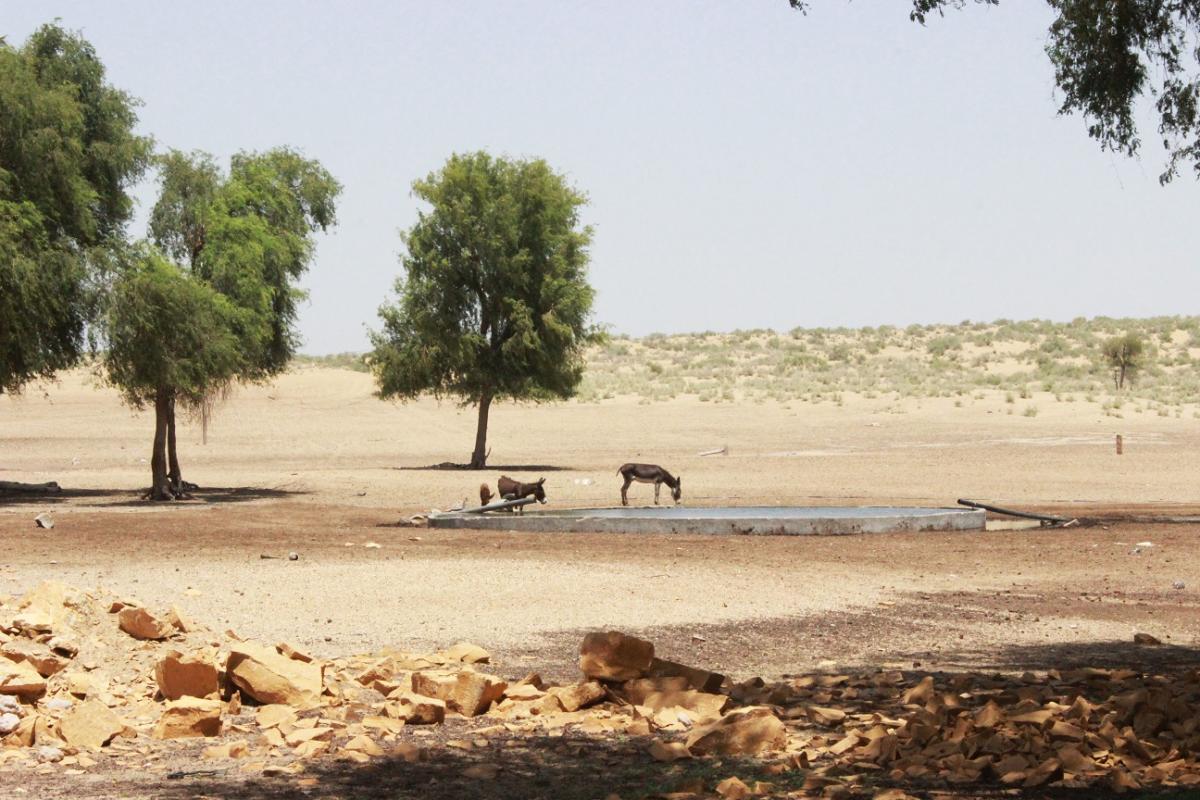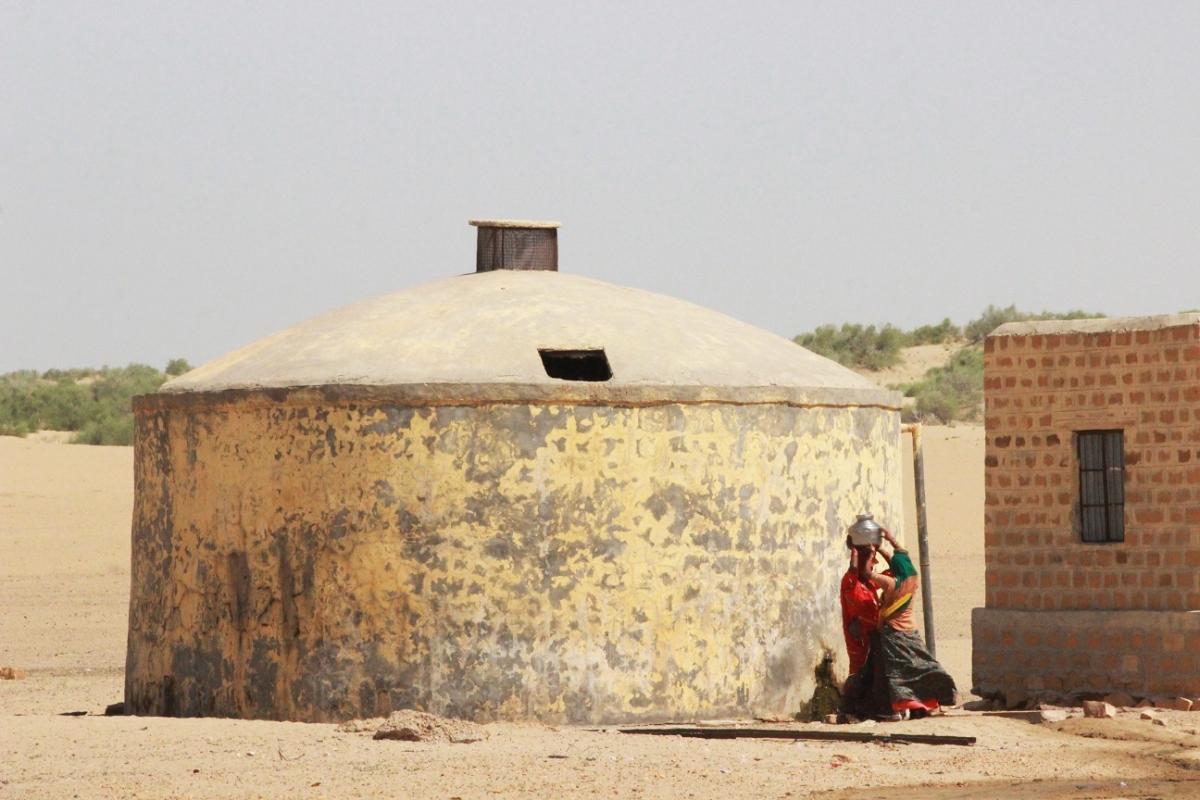Every drop of water is precious in western Rajasthan. This sun-baked swathe of arid land is dotted with ‘dhanis’, or small settlements comprising of 50-100 people and a few thousand of their domesticated animals. Remote villages such as Kisangarh and Girduwala, located close to the India-Pakistan border are a part of the Thar desert ecosystem, characterized by sandy plain and dune landscape interspersed with grasses and hardy bushes such as ‘aakdo’ and ‘thor’. This region receives less than 100-200 mm rainfall in a good year and depends solely on groundwater for sustenance.
Until recently, the only source of drinking water were the borewells installed by the Rajasthan Public Health and Engineering Department (PHED). Diesel pumps extract water from these wells about three hours per day, consuming close to 50 litres of diesel. The diesel is brought to the villages from fuel stations 100-150 kilometres away in the city of Jaisalmer. The sole teacher of the Girduwala primary school and its 12 students speaks of sandstorms that shift sand dunes during the summer and pre-monsoon months, blocking the roads and restricting access to towns and fuel stations. Without diesel in the Thar, there is no water.

Though villages were connected to the electric grid in 2019, these are single-phase connections. Since pumping water requires a three-phase connection, the electric grid is not yet a viable alternative to diesel-powered water supply systems. In addition, grid lines are often damaged by sandstorms, and given the remote location, agencies need several days (sometimes weeks) to restore power.

A few years back, the PHED built Ground Level Reservoirs (GLR) ranging in capacity from 10,000 to 20,000 litres to supply clean drinking water for the residents of nearby villages and their livestock. The GLRs, which are usually less than a kilometre away from the settlement, are covered storage tanks which are fed by water from 200- 400 feet deep borewells. Animals are fed through water troughs connected to GLRs, whereas women of the village collect water from outlet taps. Women and girls spend up to two hours each day collecting water for drinking and other domestic use. This often requires multiple trips – in extreme heat/cold conditions and at times, even during blinding sandstorms.

To provide uninterrupted supply of water in these regions, the PHED have set up solar powered units connected to 17.5 HP pumps. These solar units have 120 panels of 300V each. A local operator manages the units and provides basic maintenance activities, reducing the dependence on faraway towns. One such operator tells us that he can also grow crops such as cucumber in the shade of these solar panels.


The local operator is supported by a maintenance team operating out of the town of Jaisalmer. The maintenance team also travels to the sites regularly for check-ins with villagers and operators. Sometimes for the operator, these check-ins involve dune hopping to find a cell signal. Delays, which are par for the course, are at times caused by sandstorms shifting entire dunes on the roads.

This system provides uninterrupted water supply for livestock, wild animals, and humans. The Border Security Force (BSF), stationed at the India-Pakistan border nearby, also uses these reserves for their consumption as well as to replenish the water troughs for wild animals at the border. BSF personnel we spoke to say that without this supply, many animals would have perished due to dehydration.

The Central Ground Water Board classifies this region of India as “critical”, implying ground water resources are scant and the extraction rate is higher than that of recharge. Elsewhere in the region, rainwater gets trapped above the deeper aquifers between layers of bentonite/gypsum and the loose sand above. Colloquially known as ‘Rejwani’, this efficient traditional recharge system can replenish the aquifers. However, the 250-400 feet deep borewells which supply water to Kisangarh and Girduwala are not recharged effectively due to scanty rainfall. This has prompted the PHED to explore new sources of water for the region, including the Indira Canal which is 100 kms away.



These systems support communities during droughts, sandstorms and extreme heat. Continual access to clean water helps them cope with the unyielding harsh conditions of the region. With uncertain rainfall patterns owing to climate change and the ever-harsh environment, these interventions are the true oasis in this desert landscape. Historically, the ‘dhanis’ were named after the person who commissioned a well, underscoring the importance of water in the region. Today, the solar powered borewells play a critical role in providing safe and affordable drinking water to all, while reducing the dependence on costly diesel from faraway towns. And local residents – humans and animals – are able to access water in this ocean of sand.

This story has been sourced from WRI India. You can read the original story here.


















